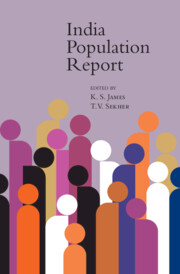1 - India's Population Change
Critical Issues and Prospects
Published online by Cambridge University Press: 15 August 2023
Summary
Demographic change has been one of the salient and defining social revolutions taking place in India since the last few decades. The key demographic processes are experiencing extraordinary changes: Women's fertility has plunged rapidly and life expectancy has climbed to new highs. The transition from a period of enormous concern on population explosion during the early part of the second half of the last century to a phase of discussion on the demographic dividend and population ageing has not been smooth but appreciable to any standard. The transition has touched many aspects of individual, household, and community lives in India. The country has already reached a desirable target of replacement-level fertility as per available data and will be entering into an era of slow or very slow population growth in the coming decades. Demographic changes create their own ripples in any society, let alone India where the transition is unconventionally defying many theories and arguments. Therefore, it is important to have a careful look into the demographic changes in India and their various facets.
Considering the sheer volume of the population size in India, the demographic changes in the country have a unique role in altering the global population scenarios. When the global community and the national governments are committed to the Sustainable Developments Goals (SDGs), India is critically significant in altering the global figures. Despite accelerated fertility decline in the country, the available population momentum will drive population growth for some more time. According to the United Nations’ World Population Prospects (2022 Revision), India is expected to overtake China as the world's most largest populous country in 2023. In this context, this book would be an important asset for researchers and policymakers to understand (a) the contemporary conditions of the Indian population, (b) the different challenges posed by geographically and socio-economically heterogeneous fertility, mortality, and health transitions and migration flows, and (c) the opportunities from the point of view of the well-being of all. The rest of the chapter is organized in three parts: The first part introduces the key components of population change (fertility, mortality, and migration); the second part discusses the consequences of population change; and the third part summarizes the contents discussed in the various chapters of the book.
- Type
- Chapter
- Information
- India Population Report , pp. 1 - 18Publisher: Cambridge University PressPrint publication year: 2024
- 1
- Cited by

